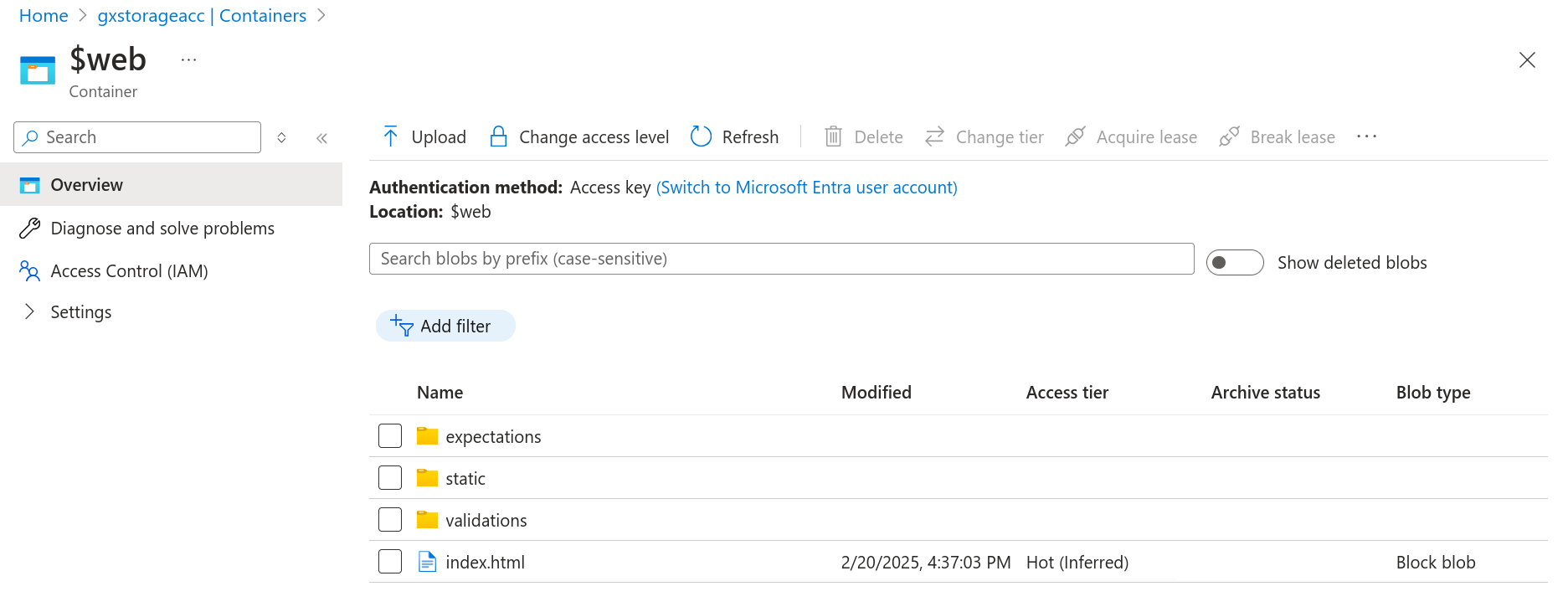Resources
- Check out the complete code on GitHub.
- Browse the GX Data Doc on Azure Blob Storage.
Use Case
Last week I explored Soda as a data quality testing framework for my large enterprise client. This week I’m exploring a more mature alternative called Great Expectations or GX in short.
GX generates neat HTML reports called Data Docs that give an overview of your data quality test results. The client wants to share these reports with the team - but not with the world! As the client is already using Azure, hosting the report files on Azure Blob Storage seems like a good solution.
Why Azure Blob Storage?
1. Easy Implementation
Installing new solutions at enterprises is notoriously difficult. There’s often a long procurement process and many budget-approval hoops to jump through. Because the client is already using Azure, it’s only a small step to provision an additional Blob Container.
2. Familiar Access Control
As the Blob Container becomes part of the client’s Azure ecosystem, the existing IT-team can easily manage access to the Data Docs using RBAC1. There are no new security-measures to implement.
Solution
This solution is a direct implementation of the GX documentation about how to host and share Data Docs on Azure Blob Storage.
Sample Data
The code defines two expectations for the following simple Pandas dataframe:
- The
NumericColumnmay only have values between 0 and 90. - The
TextColumnmay only have values from “Item 1” to “Item 10”.
NumericColumn TextColumn
0 10 Item 1
1 20 Item 2
2 30 Item 3
3 40 Item 4
4 50 Item 5
5 60 Item 6
6 70 Item 7
7 80 Item 8
8 90 Item 9
9 100 Item 10
Code
I won’t go into the same steps in detail here. Rather, I’ll highlight a couple of important points:
- I configured the following
azure_blob_storagesite definition in my great_expectations.yml file.
azure_blob_storage: # this is a user-selected name - you can select your own
class_name: SiteBuilder
store_backend:
class_name: TupleAzureBlobStoreBackend
container: \$web
connection_string: ${AZURE_STORAGE_CONNECTION_STRING}
site_index_builder:
class_name: DefaultSiteIndexBuilder
If you are running the [setup_gx.py] file for the first time, don’t forget to set
do_config = Trueand update the path inCONTEXT_DIRto your system.Don’t forget to set your Azure Blob Storage connection string in the
connection_stringoption. As this value is secret, it’s not included in my repository.
Result
I think the result looks pretty neat. The index.html along with the other files are created in a Blob Container $web:

The final result can be accessed by anyone on the internet here. We see that five GX runs have been made, resulting in five Validation Results.

Note how the Expectation Suites tab gives more information about the Expectation Suites, in this case panda_expectations. This feature gives business users clear information about how the date they’re using has been tested.
Conclusion
Overall, I quite like the Great Expectations framework so far. Comparing it to Soda Core there’s a couple of points I prefer about GX:
- GX has more open-source features, e.g. Data Docs.
- Although GX is more convoluted, the organization of Expectations into Suites allows to maintain order as the project grows.
- The community behind GX seems sufficiently active.
- No date is shared outside of the company to access certain features, as opposed to Soda Cloud.